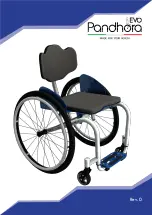
052124 Rev. B
16
E N G L I S H
K. BACK ANGLE ADJUSTMENT
The back angle is established by the interlocking of mating splined teeth of the backrest plug (A) and
backrest bracket (B). To change the angle, insert a 5 mm Allen Wrench (C) through the slot in the back
canes (
-D) and loosen the screws (
-E) on both sides of the chair until the mating splines are
allowed to freely slide past one another.
On the left side of the chair, set the back canes at the desired angle to the wheelchair frame and tighten
screw (E) to 212 in-lbs. (24Nm). Use the extension handle (F). Record the indicator hash mark position
of the backrest plug (A) and backrest bracket (B) on the left side of the chair and adjust the right side of
the chair to the identical position. Tighten the right side screw to 212 in-lbs. (24 Nm).
NOTE–
Ensure that curved surface of waser matches curved surface of back spline when tightening.
L. FITTING THE JAY
®
PRECISION BACK
The Jay Precision Back is a tension adjustable back that includes lateral support hardware. It is designed to
follow the contour of the back of the end user and provide beneficial lateral trunk control.
1. Contour Adjustment
a.
To modify the contour of the Jay Precision Back:
Pull the tensioning straps (A) inward to increase the tension and lift the tab of the tension lock
buckle to release it.
b.
To adjust the Jay Precision Back to conform with the user’s anatomy, release tension on all straps
then adjust them proceeding from the base of the back upholstery moving up.
c.
These adjustments should be done with the user sitting in the chair.
2. Lateral Supports Location Setting
a.
Remove the lateral covers (B). Leave the lateral support foam pads on.
b.
To move the lateral supports up or down loosen the screws (C) and slide them vertically until
desired location is obtained, tighten the screws to secure the lateral supports.
c.
Should more adjustment be required, two more openings are available on the back cane envelopes
to allow for height adjustment of the hardware itself. To relocate the hardware loosen the screws
(D) of the clamp until it can be taken off the cane. Move the clamp and hardware up or down as
needed and tighten the screws firmly.
d.
The lateral supports have 2 inches of adjustment range towards the inside from the external plane
of the back canes. To adjust, loosen the screws of the clamp (D), set the adjustment and tighten
them back down.
NOTE–
If adjustment pushes too far inward it will prevent the chair from folding completely.
e.
If adjusted too low, the lateral supports may interfere with the cross brace when folding the chair.
f.
These adjustments may be done with the user sitting in the chair.
M. SEAT SLING
The seat sling can be adjusted through the use of hook and loop material beneath the seat.
Seat sling also includes a folding strap on the seat to assist in folding the chair.
NOTE–
The seat sling folding strap is not intended as a carrying strap.
1. Adjustment
a.
Remove seat rail end caps at the front of the chair (A).
b.
Slide the seat sling and plastic retaining rods from the channels in the seat rails.
c.
Readjust hook and loop material to obtain the desired tension in the seat sling.
d.
Reinsert the seat sling and plastic retaining rods into the channels in the seat rails.
e.
Replace the end caps.
N. CUSHION INSTALLATION
a.
Place cushion on seat sling with hook material side down. The beveled edge of the cushion should
be in front.
b.
Press firmly into place.
21
21
20
19
17
18
18
17
A
19
18
17
A
B
D
C
F
E
B
C
D
20
21
A
A









































